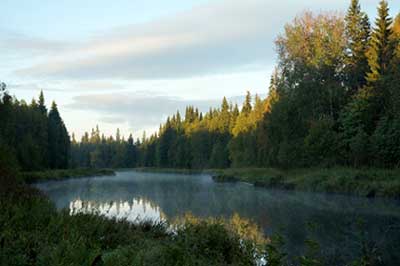- “Biotic pump theory explains the role of forests in atmospheric circulation on a planetary scale. However, if it is a major mechanism behind the water cycle it should also be applicable on a smaller scale (a watershed for example) influencing creation of a microclimate and a pattern of water distribution. Do you have any data to suggest smaller scale biotic pump action? After all Nature works on principle of fractals and it should be applicable to any scale. This seems to be evident from empirical work of Peter Andrews on restoration projects in Australia. His Natural Sequence Farming principles of landscape management described in his books “On the Brink” and “Back from the Brink” I think confirms it.”
- Answered 11 December 2012.
Question author: Sergei Karabut.
Asked 20 November 2012.
The biotic pump mechanism transports atmospheric moisture from the ocean to the forest-covered continent. This large-scale process is based on cumulative performance of many similar small-scale functional units in the forest. We termed these units “local ecological communities”. A local ecological community in the forest ecosystem is a tree with all the spatially associated local biota (including soil) — including bacteria, fungi, small invertebrates etc. Please see Section 4.3 of Gorshkov et al. (2004) for a discussion.
In simple words, the biotic pump emerges as a sum of reactions of individual trees and the associated organisms. Information about how to perform the needed reactions, like, for example, production of condensation nuclei by tree-dwelling fungi, is written in the genome of forest species. This information appeared in the course of biological evolution. They must therefore impart some noticeable advantage to individual ecological communities on a local scale. (Please see Section 4 “Biological principles of the biotic pump of atmospheric moisture” in Makarieva and Gorshkov (2007) for a more extensive discussion of this topic.)
To evaluate the biotic pump performance of a single tree or a small forested area it is necessary to measure how the local influx of atmospheric moisture has changed upon the tree re-growth. Whether it is measurable depends on the sensitivity of natural selection. If it is higher than the accuracy of our measurements, it will not be possible to detect a small-scale biotic pump. The signal from a small area will be lost in the high fluctuations of the local moisture transport and rainfall processes.
The biotic pump enabled life to colonize land. The first plants capable of running the pump originated at the coastline. This narrow band of plants was obviously unable to draw moisture far inland. However, these plants might have been able to slightly increase local rainfall making the prevailing winds to slightly change their path. For example, the plants could enhance intensity of local condensation and modify local pressure gradients by emitting biogenic condensation nuclei. Gradually spreading inland the plants were bringing moisture with them — by enhancing the atmospheric water vapor flow. Thus, a group of trees planted in the desert may not have any biotic pump potential at all, as it has no link to the oceanic source of moisture.
On the other hand, the biotic pump is based on a large number of evolutionary properties of various species. Among them is the ability of the ecological community to efficiently store moisture in soil, to regulate the vertical temperature gradient under the canopy, to modify aerodynamic roughness of the area etc. These properties profoundly influence the local microclimate and are readily observable on a small scale.


Thanks for the good question Sergei
The Nga Hua a Tane school based rainforest research program in Whirinaki, Te Urewera, New Zealand aims to help answer this and many other related questions. The catchment here is around 32,600 hectares, surrounded mainly by native forest and around 80k from the coast. Next year, comparisons of environmental conditions in the diverse old native forest, commercial pine forestry, farming and wetland landuse areas in the catchment will be measured.
All research to date including weblinks, weatherstation and river outflow records are shared on the web as an exploratory learning resource for others to uses and analyse if they wish at: http://www.whirinakirainforest.info/ecosystem_services_value.
We have been very grateful for the advice and encouragement of Victor and Anatassia plus Peter Bunyard in Columbia and a network of other international rainforest researchers who are probing in this area.
Nothing so far contradicts the biotic pump theory. In fact our school students inherently understand that water from the catchment floes downhill via the river to the sea, and that if there was not some other gradient present to attract it back as vapour (water does not naturally run uphill!), then the catchment would soon dry out!
Students in New Zealand studying the local action of biotic pump. The hanging fan comes on to emulate the biotic pump, and you can see the air freshener aerosol that squirts to a mist to emulate forest aerosols.